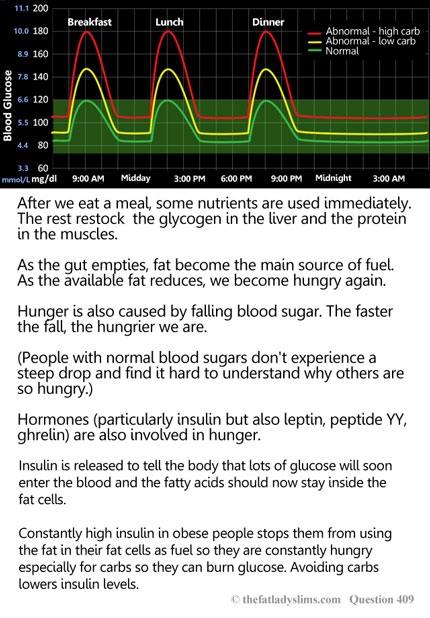
References
"Overweight premenopausal women consumed a low-carb/high-protein …or high-carb/low-fat diet. For 6 weeks. All women experienced a reduction in [body weight], although relative BW loss was greater in the low-carb/high-protein… self-rated hunger decreased in women in the low-carb/high-protein but not in the high-carb/low-fat group from baseline to week 6. " Nickols-Richardson, 2005, Perceived hunger is lower and weight loss is greater in overweight premenopausal women consuming a low-carbohydrate/high-protein vs high-carbohydrate/low-fat diet. , J Am Diet Assoc. 2005 Sep;105(9):1433-7.,
"in free-feeding rats…. Transient declines in blood glucose preceded each meal; transient declines in blood glucose with the necessary shape and magnitude are reliable signals for feeding that are detected by central nervous system glucose receptive elements and are mapped into meal initiation." Campfield, L. A., & Smith, F. J. (1990). Transient declines in blood glucose signal meal initiation. International journal of obesity, 14 Suppl 3, 15–31; discussion 31–4.
"The rapid absorption of glucose after consumption of high-GI meals induces a sequence of hormonal and metabolic changes that promote excessive food intake in obese subjects." Ludwig, D. S., Majzoub, J. A., Al-Zahrani, A., Dallal, G. E., Blanco, I., & Roberts, S. B. (1999). High Glycemic Index Foods, Overeating, and Obesity. PEDIATRICS, 103(3), e26–e26. doi:10.1542/peds.103.3.e26
"I’m reminded of how confused mainstream nutrition and obesity research is. All of these other hormones – leptin, peptide YY, ghrelin – are reported to play a role in appetite. The notion that 'the answer' to treating obesity lies in manipulating these hormones suggests folks still think obesity is a disease of over-eating rather than a disorder of abnormal fat accumulation. This distinction is not subtle... If you believe obesity is caused by overeating then it makes sense to study hormones that govern hunger [otherwise you need to study insulin]." Peter Attia, M.D, [from web-page]
"Compared with an isocaloric low-GI meal, a high-GI meal decreased plasma glucose, increased hunger, and selectively stimulated brain regions associated with reward and craving in the late postprandial period, which is a time with special significance to eating behavior at the next meal." Lennerz, B. S., Alsop, D. C., Holsen, L. M., Stern, E., Rojas, R., Ebbeling, C. B., Goldstein, J. M., et al. (2013). Effects of dietary glycemic index on brain regions related to reward and craving in men. American Journal of Clinical Nutrition. doi:10.3945/ajcn.113.064113
Graph adapted from What is Normal Glucose? – Continuous Glucose Monitoring Data from Healthy Subjects, Christiansen, Prof. J. S., Annual Meeting of the EASD, Copenhagen, 13-Sep-06
and
Ando, K., Nishimura, R., Tsujino, D., Seo, C., & Utsunomiya, K. (2013). 24-Hour Glycemic Variations in Drug-Naïve Patients with Type 2 Diabetes: A Continuous Glucose Monitoring (CGM)-Based Study. PloS one, 8(7), e71102. doi:10.1371/journal.pone.0071102
and
Walsh, C. O., Ebbeling, C. B., Swain, J. F., Markowitz, R. L., Feldman, H. A., & Ludwig, D. S. (2013). Effects of diet composition on postprandial energy availability during weight loss maintenance. (S. B. Votruba, Ed.)PloS one, 8(3), e58172. doi:10.1371/journal.pone.0058172
Wikipedia: Blood Sugar











